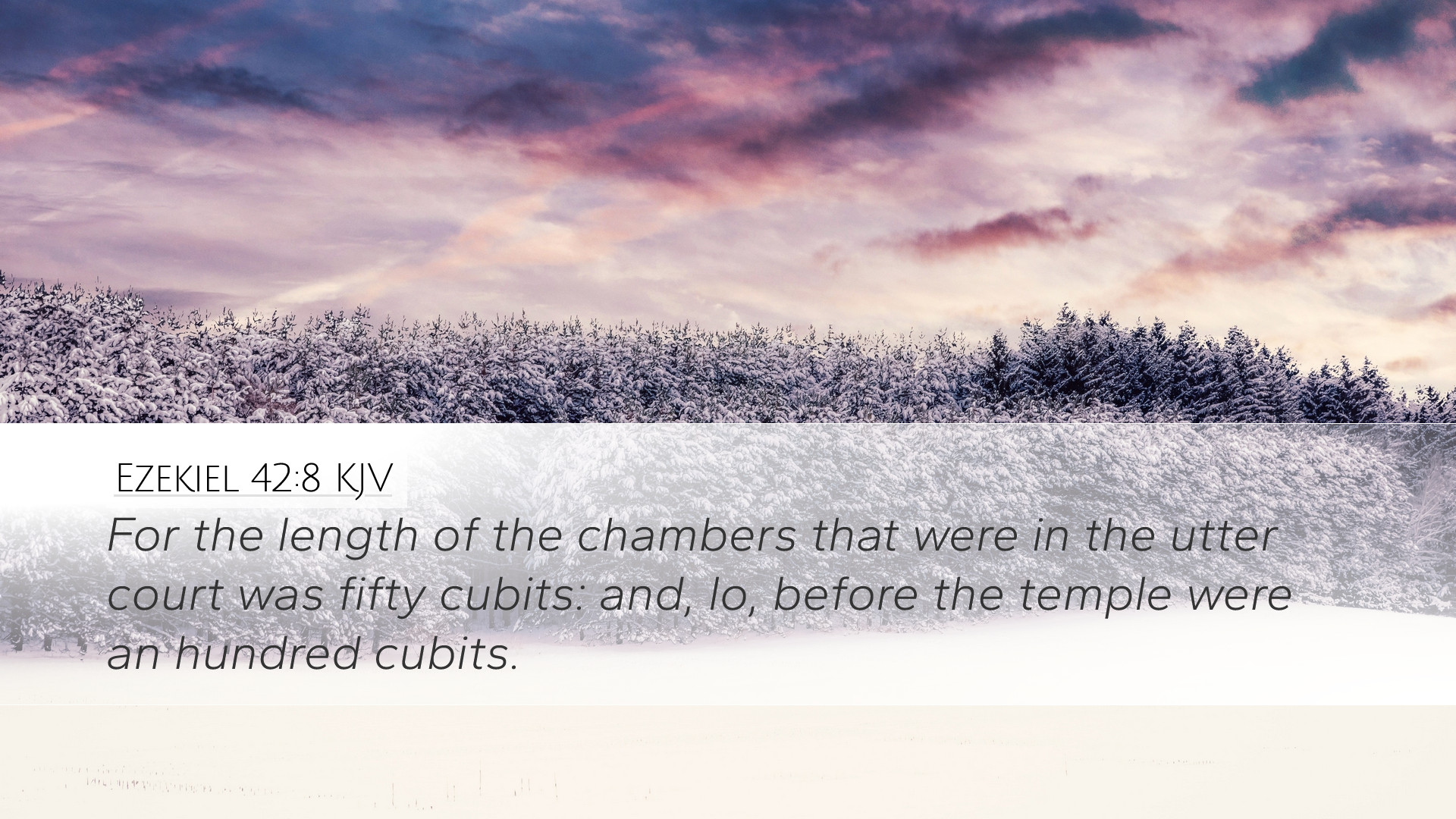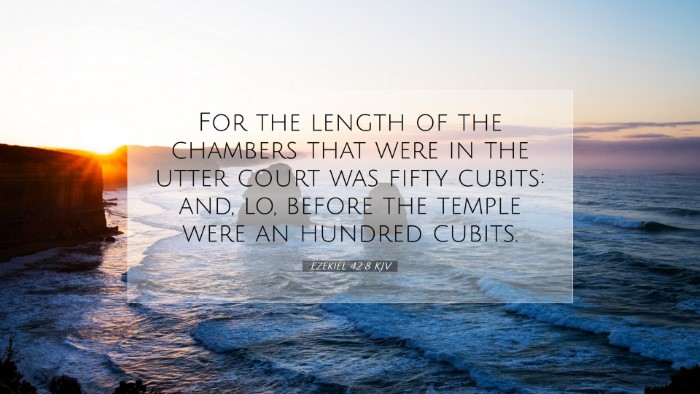Ezekiel 42:8 Commentary
Verse: "The depth of the chambers was a hundred cubits on the eastern side; this was the length of the chambers that were to be destroyed." (Ezekiel 42:8)
Contextual Overview
The Book of Ezekiel offers profound insights concerning the vision of the temple, where Ezekiel receives a divine revelation about the future temple of God and the restoration of the Israelites. Chapter 42 highlights the architectural and ritualistic complexities of the temple, emphasizing the holiness of God and the significance of proper worship.
Commentary Insights
Matthew Henry's Commentary
Matthew Henry emphasizes that the chambers mentioned in Ezekiel 42:8 represent spaces that reflect God's order in worship. The measurement of a hundred cubits signifies completeness, embodying the perfection in God's design for worship. Henry reflects on the spatial arrangement of these chambers as serving specific purposes, indicating that God's presence is not only a matter of proximity but also of sanctity.
He notes, "These chambers were meant for the priests, and they signify that in the presence of God there are designated places for waiting upon Him. The orderliness of these chambers points to the necessity for ministry conducted in holiness."
Albert Barnes' Commentary
Albert Barnes provides a detailed analysis of the structural attributes of the chambers. He mentions that the description of a hundred cubits reflects the serious nature of the oversight and the dimension of the sanctuary's design. Barnes speaks to the depth of the chambers as significant; they are symbolic of the depths of spiritual experience that God desires for His people.
He observes, "In every part of the temple, we find that dimensions play a crucial role in indicating the severity and majesty of God's dwelling place. The requirement for measurement illustrates the care God takes in ensuring His holiness is upheld through appropriate spatial separation."
Adam Clarke's Commentary
Adam Clarke examines the prophetic nature of Ezekiel's visions, highlighting that the chambers serve as a template for understanding the spiritual dimension behind physical spaces. He underscores the significance of the statement, "this was the length of the chambers that were to be destroyed," interpreting it as a prophetic warning regarding the consequences of neglecting holiness in worship.
Clarke posits, "The hundred cubits is not merely a measurement but serves as a metaphorical threshold, inviting reflection on depth of commitment and fidelity in service to God." He regards these chambers as a reminder that God’s house is to be cared for and treated with utmost respect, linking the physical design back to spiritual discipline.
Theological Implications
- Holiness of God: The sacredness of the temple space is vital, as it reflects God's nature and demands a corresponding purity from His people.
- Order in Worship: The structured design of the temple emphasizes that worship should not be haphazard; rather, it demands serious attention to detail.
- Spiritual Depth: The measurements illustrate the depth that believers must cultivate in their relationship with God, suggesting that worship is a profound experience calling for engagement at multiple levels.
- Prophetic Significance: The mention of destruction within the context of the temple underscores the ramifications of disobedience and neglect towards God’s ordained structures.
Practical Applications
For pastors, students, theologians, and scholars, Ezekiel 42:8 serves as a call to reflect on the nature of worship and holiness. Here are some applications:
- Preparation for Worship: Just as the chambers required careful design, worship requires preparation and intentionality; leaders should encourage congregations to approach worship sincerely and with reverence.
- Spiritual Disciplines: The principles seen in the design should lead to discussions about establishing spiritual disciplines that help congregants grow in their faith and understanding of God, fostering environments for deeper engagement.
- Awareness of Judgment: Understanding the prophetic undertones serves as a reminder that neglecting God’s call results in judgment. There should be a communal reflection on living in a manner aligned with God’s will.
- Leadership Structure: Just as the temple had designated chambers, a healthy church structure prioritizes accountability, teaching, and servant leadership.
Conclusion
In Ezekiel 42:8, we find a rich tapestry of theological reflection on the nature of God as holy, the requirements of worship, and the prophetic implications for Israel and the Church today. This verse challenges us to not only understand the architectural significance of the temple but also to internalize the depth of relationship that God desires from His people.


